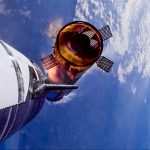
In a vast Florida hangar almost 20 years ago, NASA scattered debris from the Columbia Space Shuttle crash across the floor. Accident investigators bent over the burnt and mangled wreckage, trying to understand what happened.
Search parties had combed forests and bogs from Central Texas to Louisiana to find 82,000 fragments from the disaster that killed one Israeli and six U.S. astronauts. A little over one-third of the spacecraft’s weight returned to Kennedy Space Center in shattered pieces.
But two months after the fiery explosion that obliterated the shuttle, one remnant recovered was so unimaginable that, to this day, it boggles the mind: a clump of paper from the flight diary of Ilan Ramon, Israel’s first astronaut. Today, a copy of some of the salvaged pages makes its return to space with Eytan Stibbe, the first Israeli astronaut to follow in Ramon’s footsteps.
-
A little-known U.S. spaceport shoots into the big rocket scene
-
Your next skin cream may come from NASA’s outer space science
-
NASA didn’t invent Velcro. But it did dream up these surprising things.
Stibbe joins three other private astronauts on the first all-private expedition to the International Space Station. The 10-day mission, led by commercial company Axiom Space, sees the astronauts lift off in a SpaceX Dragon to conduct experiments in the laboratory’s unique microgravity environment. They’re expected to dock at the station early Saturday morning.
The mission will earn its place in history for expanding the definition of “astronaut.” For decades, that title was reserved for government space pilots and crew. More recently, uber-rich space tourists riding the likes of Blue Origin, SpaceX, and Virgin Galactic have earned the distinction by breaching Earth’s atmosphere.
With this new voyage comes a third possible description: Someone privately trained and launched into space to perform commercial scientific research.
“It’s important to address the difference between space tourists and private astronauts,” said Larry Connor, the pilot, during a news conference last week. “Our feeling is with the space tourists, they’ll spend 10 or 15 hours training for five to 10 minutes in space — and by the way, that’s fine. In our case, depending upon our role, we’ve spent anywhere from 750 to over 1,000 hours training.”

Credit: Chris Gunn for Axiom Space

Credit: NASA / Getty Images
About a week ago, Stibbe said he planned to bring the diary, along with a song written by one of Ramon’s sons and artwork by his daughter. The painting depicts pages falling out of the sky.
Stibbe said he still recalls that catastrophic day, Feb. 1, 2003.
“It’s very emotional,” he said. “He was a good friend.”
When Stibbe was a fighter pilot in the Israeli Air Force, Ramon was his squadron commander. He visited Ramon at the NASA Johnson Space Center in Houston during his astronaut training, the same place where he recently received his own training for the Axiom mission.
“On that tragic day of the accident, I was at the squadron, watched with all of the Israeli people, and it was a very painful day,” Stibbe said.
Since then, his family has stayed close with Ramon’s.

Credit: Bob Daemmrich / Corbis Sygma / Getty Images
The recovery of the diary sounds like the stuff of folklore. A person with tracking skills, derived from ancient hunting practices of indigenous groups, discovered the pages two months after the accident, according to Associated Press reports. The notebook had plunged 37 miles to Earth and survived fire, rain, and sun bleaching, lying damp in a San Augustine County, Texas, field with other debris.
Other news reports have erroneously claimed the diary was found near the town of Palestine, about 100 miles west of the county, adding to the mythical quality of finding the Israeli astronaut’s last writings. Some reported that 18 pages were found, a number that coincidentally bears significance in Jewish mysticism.
At the time, NASA spokesman James Hartsfield said the agency returned any personal items to the deceased astronauts’ families. He declined to identify those objects out of privacy concerns, according to the AP wire report.

Credit: NASA / Getty Images
Rona Ramon, the astronaut’s widow, gave the illegible paper to the Israeli Police for forensic analysis. The results of that study were published in the Journal of Forensic Sciences in April 2007, with several images of the items as they were found in the field and how bits of paper were matched in the lab. Most of the pages recovered were torn and washed out, some speckled with yellow fungus spores, but were “only mildly charred around the edges.”
“The random pile of papers was found to have survived the calamity of the Shuttle’s disintegration remarkably well,” the authors wrote.
In all, there were eight sides of paper Ramon had written in space with black ink and pencil, six sides of technical notes he wrote before the mission, eight sides of personal notes written before the mission in blue ink, and a few sides of printed technical information, according to the forensic analysis. Scientists used several techniques to restore and decipher the pages, including infrared and ultraviolet light and computer-enhancement technology.
“… only mildly charred around the edges.”
Among the writings the diary pages contained were a list of topics Ramon intended to discuss during a broadcast, a mention of a card game the astronauts played in their spacesuits right before the launch, and a copy of the Kiddush, a Hebrew blessing uttered during the Sabbath over wine.
After the pages were examined, they were given to the Israel Museum for restoration and preservation. An exhibit in Ramon’s memory showcases some of the documents.

Credit: Roberto Schmidt/AFP/GettyImages
It’s not clear what NASA thinks about the forensic findings. The agency hasn’t said anything publicly about the diary, its recovery, or its contents. An information request from Mashable to Kennedy Space Center regarding the diary wasn’t immediately returned.
Stibbe said he will honor his friend’s legacy by continuing research he started two decades ago involving the observation of thunderstorms. And, like Ramon, he will carry out some Jewish traditions in space. Due to launch delays, the flight’s schedule was pushed to overlap with Passover, the Jewish holiday celebrating freedom from bondage in Egypt thousands of years ago.
“We have several traditions in that feast, including drinking at least four glasses of wine,” Stibbe said. “I took a wine glass with me, but I don’t think I will find any wine in the station.”
“And,” given the lack of gravity, he added, “I don’t think I need a glass to drink wine.”
Powered by WPeMatico






